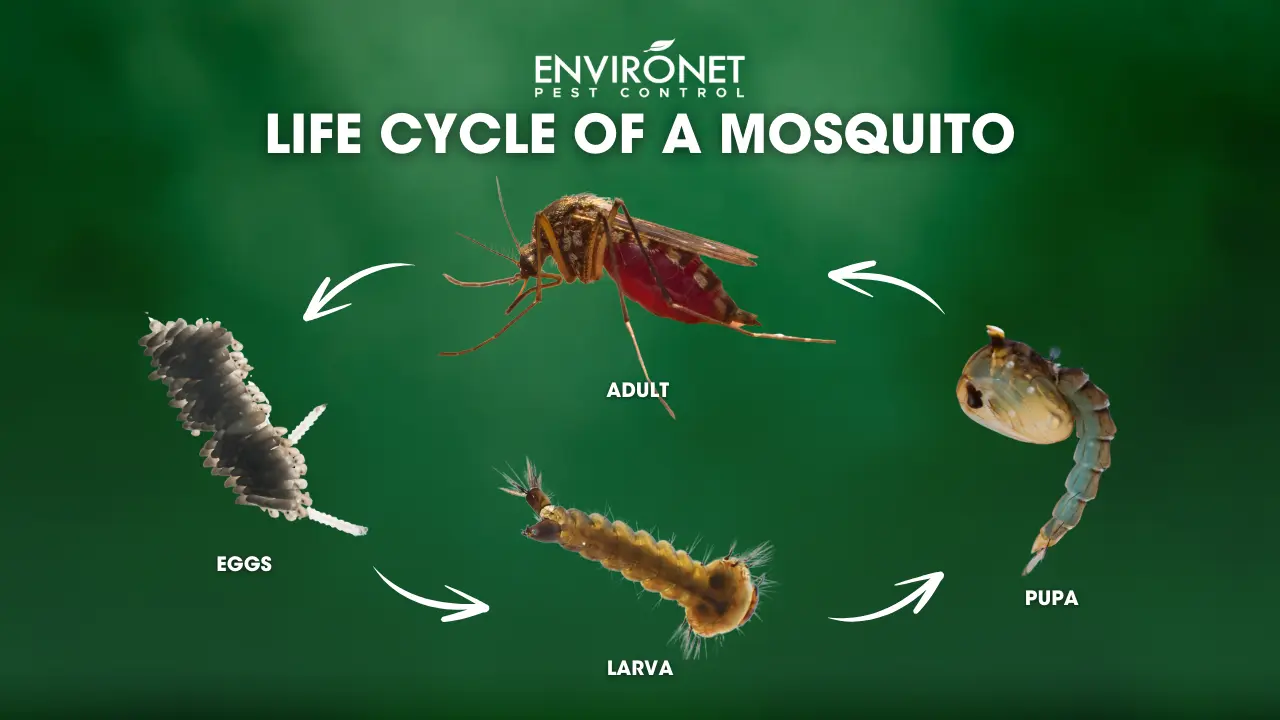
Understanding the Life Cycle of a Mosquito
Last updated on September 3rd, 2024 at 01:45 pm
Mosquitoes are more than just annoying pests; they are vectors for serious mosquito-borne diseases. Understanding their life cycle and local mosquito species is crucial for effective pest control and prevention strategies. Here’s a closer look at the four stages of a mosquito’s life, including some fascinating mosquito facts:
- Egg Stage
- Larva Stage
- Pupa Stage
- Adult Stage
Life Cycle of a Mosquito
1. Egg Stage
A female mosquito lays their eggs and usually the eggs hatch on water surface or near water. A single female mosquito can lay up to 100 eggs at a time, often in clusters. These eggs are resilient, capable of withstanding dry conditions for several months until they are submerged in water. The water temperature plays a crucial role in the hatching process, with warmer temperatures generally speeding up development.
2. Larva Stage
Once the eggs hatch, they enter the larval stage. Larvae, commonly known as “wrigglers,” live in the water and come up to the surface to breathe. During this stage, they molt several times as they grow, feeding on microorganisms and organic matter in the water. This stage is critical to monitor for local species in the Philippines to ensure effective control.
3. Pupa Stage
The pupa stage, or “tumbler,” is a transitional phase where the larva transforms into an adult mosquito. Pupae do not feed, and this stage lasts for a few days. Pupae are active and respond to light changes by swimming downward.
4. Adult Stage
The final stage is the emergence of the adult mosquito. After resting on the water’s surface and allowing their body parts to dry and harden, the adult mosquito emerges ready to fly. Only the female mosquito seeks a blood meal to develop their eggs, leading to mosquito bites, as female mosquitoes are attracted to carbon dioxide exhaled by humans and animals, which helps them locate their hosts. While male mosquitoes primarily feed on nectar.
Prevention Tips
Understanding these stages is essential for controlling mosquito populations:
- Remove standing water: Regularly check and eliminate mosquito breeding places where mosquitoes can lay eggs.
- Use larvicides: Treat water with larvicides to kill larvae before they become adults.
- Install screens and use repellents: Protect yourself by using window screens as part of pest-proofing and applying mosquito repellents.
-
Use plants that repel mosquitoes: Certain plants, such as citronella and lavender, can help repel mosquitoes naturally.
By breaking the life cycle at various stages, we can significantly reduce mosquito populations and the risk of mosquito-borne diseases. Knowing how to avoid mosquitoes especially female mosquitoes is essential for maintaining a healthy living environment.
Conclusion
In conclusion, understanding the life cycle of mosquitoes is not only fascinating but also vital for effective pest control and the prevention of mosquito-borne diseases. Each stage of their development, from egg to adult, presents unique opportunities for intervention. By implementing targeted strategies such as eliminating standing water, using larvicides, installing screens, and employing natural repellents, we can disrupt their life cycle and significantly reduce their populations. This knowledge empowers us to create a safer and healthier environment, free from the dangers posed by these persistent pests.
If you have mosquito problem, book our Mosquito Control Service today!
